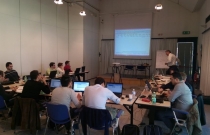Implementing Renewable Generation and Storage and Simulating Their Effects on the Grid and Power Electronics (HVDC and FACTS)
24.04.2015
Training was held in CESI premises in Milan, and there were 12 trainees.
Duration: 2 and 3 days
Contents (Part 1):
- Quick review of WIND FARMS and PHOTO-VOLTAIC theory
- Review of the available library models
- Quick review of the typical issues related to the usage of WIND FARMS an PHOTO-VOLTAIC
- Examples-exercises in the usage of WIND FARMS and PHOTO-VOLTAIC aimed at representing the typical issues included in the previous point
- Quick review of BATTERY STORAGE
- Review of the available library models
- Examples-exercises in the usage of BATTERY STORAGE for mitigating the issues related to the intermittency and low capabilities of WIND FARMS and PHOTO-VOLTAIC
Note: The following concepts have been included:
- Synthetic inertia
- Capabilities
- Behavior of WIND FARMS, PHOTO-VOLTAIC and BATTERY STORAGE in case of symmetrical and non-symmetrical short-circuits
- Implementation of WIND FARMS, PHOTO-VOLTAIC and BATTERY STORAGE in PSSE static and dynamic model
- Symmetrical and non-symmetrical short- circuit calculation in presence of WIND FARMS, PHOTO-VOLTAIC and BATTERY STORAGE
- Symmetrical and non-symmetrical short- circuits time domain simulation in presence of WIND FARMS, PHOTO-VOLTAIC and BATTERY STORAGE
- Simulation of the behavior WIND FARMS, PHOTO-VOLTAIC and BATTERY STORAGE case of severe frequency-voltage transients
- Simulation of the intermittence of WIND FARMS and PHOTO-VOLTAIC
- Simulation of the energy variation of BATTERY STORAGE during large transients
Contents (Part 2):
- HVDC Basics (including conventional, multi-terminal, single pole and bipolar, LCC, VSC)
- HVDC – Controls and Protection (including fast power reverse facility, synthetic inertia and power oscillation damper)
- HVDC Modeling (including HVDC types mentioned in point a. and controls and protections mentioned in point b.)
- Introduction to the typical static and dynamic studies to be performed during the lifecycle of HVDC Systems (focus on the subset of studies which can be performed using PSSE)
- FACTS – Basics
- FACTS - Modeling
- Examples and exercises as in the following:
- Behavior of filters and reactive control compensation
- Black-start on a passive network (applicable only for VSC type)
- Behavior in case of symmetrical and non-symmetrical short-circuits and effect of the commutation failure
- Examples based in the typical studies
- Interaction between HVDC controls and FACTS

